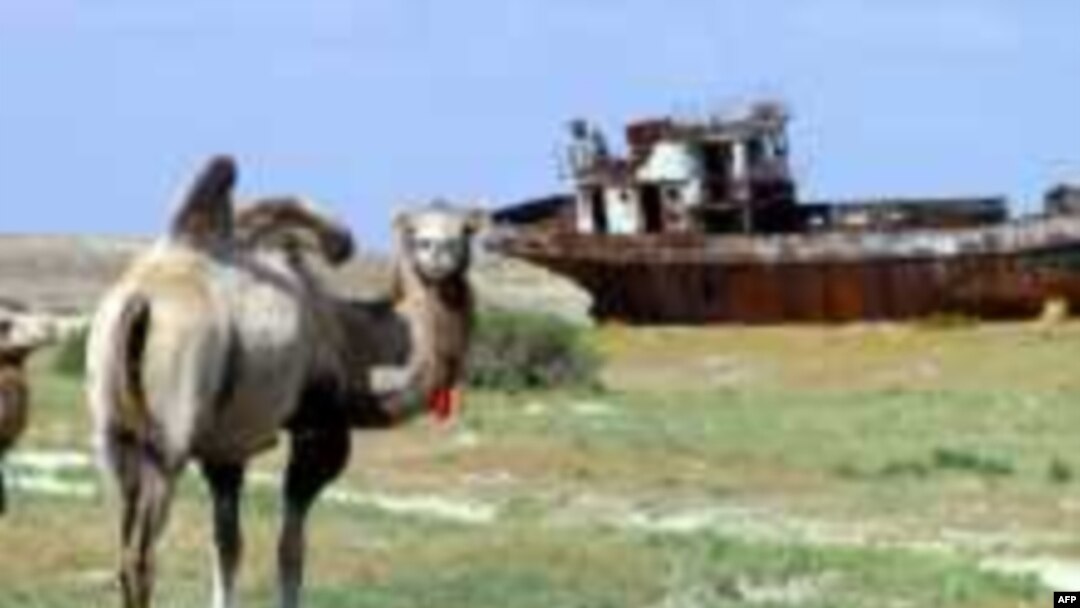PRAGUE, September 18, 2006 (RFE/RL) -- The Aral Sea environmental disaster is a stark example of what can go wrong when mankind interferes in an ecological system without understanding the consequences of its actions.
The Aral Sea in Central Asia was once the world's fourth-largest freshwater lake, but because so much water has been taken out of its river systems to irrigate crops, it has shrunk to 25 percent of its former size.
Aral Sea Disaster
The remains of fishing boats now lie rotting in an arid landscape, and the diverted water is increasing the salinization of the irrigated soils, threatening desertification over a vast area.
With this grim scenario in mind, scientists from Germany's Center for Development Research at Bonn University teamed up with Uzbek scientists in 2001 on a long-term project to develop ways to stop the damage.
Project coordinator Christopher Martius told RFE/RL that a lot of time has been spent getting to understand the problems involved.
"We found out that many of the things being said about the Aral Sea and the problems of the region are misinterpreted," he said. "You have to be really present in the region to get the problem statements right in the first place, and this is what we have done so far, and now we are heading to the third phase in which we want to develop our concepts further, test them on the ground, [and] with farmers."
Improve Upstream Soil
Acceptance of the measures by the farmers is key, as it is they who must work to improve the soil and use less water. Soon the scientists should be able to provide the Uzbek government a functioning model based on proven concepts for combatting ecological degradation, and thus rural poverty.
What are these concepts? Martius outlines a package of measures which are not revolutionary, being mainly long-established recommmendations for environmentally-sound farming. What is revolutionary, says Martius, is the way different ideas are being combined to create an integrated whole.
"We are trying to improve the water-use efficiency in the land-use systems, in the agricultural systems, which are at present dominated by cotton production, wheat production, and some rice -- and we all know that rice is a very highly water-consuming crop, and so we try to improve the water use, but not only on the fields," he said. "You have to look at water administration, distribution, irrigation, and drainage systems; also the systems of water channels which are mostly built in sand, causing huge water losses."
The reforesting of the land by planting quick-growing trees is also an important element in the plan, as trees protect against wind erosion, return biological material to the soil, provide food for animals, and firewood.
Indigo -- The Less Thirsty Crop
"The other side [of the story] is soil quality, which is degrading due to many, many years of monoculture," he said. "So by having a high diversity of crops in the region you can improve the soil, you can improve the water balance, and you can make farmers less dependent on one or two crops, less dependent on the world market prices for these crops, and hopefully provide them with prospects for a better income."
Another idea that will be suggested is the cultivation of the indigo plant. Indigo, a natural dye giving an intense blue color, is a high-value crop. In association with the United Nations, test patches of indigo are being grown, and thought is being given to how the dye can be extracted.
"It will be a niche crop, it will not cover the whole area, but it will give farmers an opportunity to have -- on a very small piece of land -- a quite high income, so that they receive a very good contribution to the household economy," Martius said.
Contrary to cotton, which is a thirsty crop and which exhausts the soil, indigo can help improve the soil -- not degrade it.
The joint German-Uzbek project is aimed primarily at improving the condition of the upstream irrigation systems -- not at improving the overall condition of the Aral Sea. Some 40 million people depend on the upstream water for their crops.
Restoring the original flow into the Aral Sea would ruin the livelihoods of many of these people.
Sadly, it looks like the Aral Sea will have to remain a shadow of its former self for the time being.
RFE/RL Central Asia Report
SUBSCRIBE For regular news and analysis on all five Central Asian countries by e-mail, subscribe to "RFE/RL Central Asia Report."


